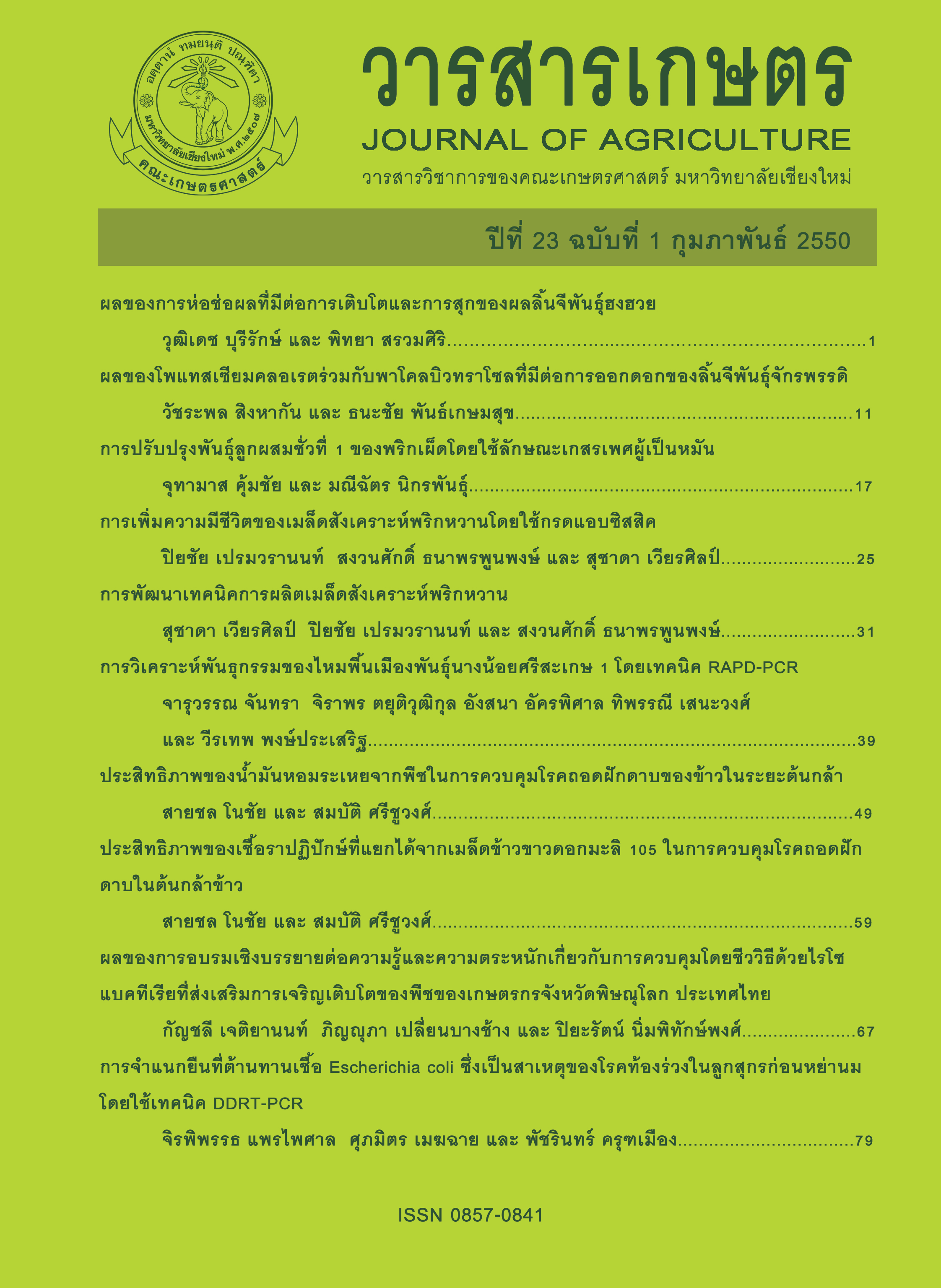การจำแนกยีนที่ต้านทานต่อเชื้อ <I> Escherichia coli </I> ซึ่งเป็นสาเหตุของโรคท้องร่วงในลูกสุกรก่อนหย่านมโดยใช้ เทคนิค DDRT-PCR
Main Article Content
บทคัดย่อ
โรคท้องร่วงที่มีสาเหตุจากเชื้อ Escherichia coli (E. coli) เป็นปัญหาสำคัญในอุตสาหกรรมการผลิตสุกรในระยะก่อนหย่านม ทำให้เกิดความสูญเสียทางเศรษฐกิจในระดับสูง โดยลักษณะความอ่อนแอ หรือความต้านทานต่อเชื้อ E. coli ในสุกรนั้น เกิดจากการปรากฏหรือไม่ปรากฏตัวรับ (receptor) บน brush border ของผนังลำไส้เล็กของลูกสุกร ซึ่งมีความสัมพันธ์กับการยึดเกาะได้หรือไม่ได้ของเชื้อ E. coli ในการศึกษาครั้งนี้ลักษณะความต้านทานและความอ่อนแอต่อเชื้อ E. coli ในลูกสุกรระยะก่อนหย่านม ถูกจำแนกโดยวิธี adhesion test และเทคนิค Differential display reverse transcription polymerase chain reaction (DDRT-PCR) ถูกนำมาใช้ในการค้นหายีนที่แสดงออกแตกต่างกันใน brush border ของลูกสุกรทั้งสองกลุ่ม โดยใช้ชุดไพรเมอร์จำนวน 12 คู่ (dT12VG anchored และ arbitrary primers) ผลการทดสอบ adehesion test พบว่าสุกรที่มีลักษณะอ่อนแอต่อเชื้อ E.coli K88 มีเปอร์เซ็นต์การยึดเกาะของเชื้อ E. coli กับ brush border เท่ากับ 32% ในขณะที่สุกรที่มีลักษณะต้านทาน มีค่าเท่ากับ 7 % (P<0.05) ผลจากการคัดกรองเครื่องหมายโมเลกุล cDNA-DDRT-PCR ด้วยไพรเมอร์ดังกล่าว สามารถเพิ่มจำนวนแถบ cDNA ที่มีขนาดในช่วง 150-570 bp เป็นจำนวน 512 แถบ ซึ่งมีค่าเฉลี่ยเท่ากับ 42.67 แถบต่อคู่ไพรเมอร์ นอกจากนี้แถบ cDNA ที่ปรากฏแตกต่างกัน (differential cDNA fragment) ระหว่างสุกรทั้งสองกลุ่ม มีจำนวน 12 แถบ โดยปรากฏอยู่ในกลุ่มของลูกสุกรที่มีลักษณะต้านทานและอ่อนแอต่อเชื้อ E. coli K88 จำนวน 5 และ 7 แถบ ตามลำดับ เครื่องหมายโมเลกุล DDRT-PCR ดังกล่าว ถูกโคลน และวิเคราะห์ลำดับนิวคลีโอไทด์ ซึ่งมีเพียง 5 โคลนที่ประสบความสำเร็จ โดย 3 โคลน (ZP18B3, ZP24B2 และ ZP18B1) พบว่าเหมือน (homology) กับยีน Dipeptidyl-peptidase I precursor (DPPI) ยีน S-Adenosylhomocysteine hydrolase (AHCY) และ EST ที่มีการแสดงออกในตับของสุกร (AK232914) ตามลำดับ ส่วนอีก 2 โคลน (ZP01B1 และ ZP17B1) พบว่าเป็นยีนใหม่ ซึ่งไม่ปรากฏอยู่ในฐานข้อมูลของ GenBank ซึ่งยีนเหล่านี้จะถูกใช้เป็น candidate gene สำหรับศึกษาลักษณะความต้านทาน หรือความอ่อนแอต่อเชื้อ E. coli ที่เป็นสาเหตุของโรคท้องร่วงในลูกสุกรในระยะก่อนหย่านมต่อไป
Article Details
เอกสารอ้างอิง
Altschul, S.F., T.L. Madden, A.A. Schaffer, J. Zhang, Z. Zhang, W. Miller and D.J. Lipman. 1997. Gapped BLAST and PSI-BLAST: A new generation of protein database search programs. Nucleic Acids Res. 25: 3389-3402.
Baker, D.R., L.O. Billey and D.H. Francis. 1997. Distribution of K88 Escherichia coli-adhesive and nonadhesive phenotypes among pigs of four breeds. Vet. Microbiol. 54: 123-132.
Bauer, D., H. Muller, J. Reich, H. Riedel, V. Ahrenkiel, P. Warthoe and M. Strauss. 1993. Identification of differentially expressed mRNA species by an improved display technique (DDRT-PCR). Nucleic Acids Res. 21: 4272–4280.
Francis, D.H., P.A. Grange, D.H. Zeman, D.R. Baker, R. Sun and A.K. Erickson. 1998. Expression of mucin-type glycoprotein K88 receptors strongly correlation with piglet susceptibility to K88 enterotoxigenic Escherichia coli, but adhesion of this bacterium to brush borders does not. Infect. Immun. 66: 4050-4055.
Grange, P.A., M.A. Mouricout, S.B. Levery, D.H. Francis and A.K. Erickson. 2002. Evaluation of receptor binding specificity of Escherichia coli K88 (F4) fimbrial adhesion variants using porcine serum transferrin and glycosphingolipids as model receptors. Infect. Immun. 70: 2336-2343.
Hermes, M., H. Osswald and D. Kloor. 2006. Role of S-adenosylhomocysteine hydrolase in adenosine induced apoptosis in HepG2 cells. Exp. Cell Res. 313: 264-283.
Hsiung, H.M., D.L. Smiley, X.Y. Zhang, L. Zhang, L.Z. Yan, L. Craft, M.L. Heiman and D.P. Smith. 2005. Potent peptide agonists for human melanocortin 3 and 4 receptors derived from enzymatic cleavages of human -MSH(5–22) by dipeptidyl peptidase I and dipeptidyl peptidase IV. Peptides 26: 1988–1996.
Hu, Z.L., J. Hasler-Rapacz, S.C. Huang and J. Rapacz. 1993. Studies in swine on Inheritance and variation in expression of small intestinal receptors mediating adhesion of the K88 enteropathogenic Escherichia coli variants. J. Hered. 84: 157-165.
Meijerink, E., S. Neuenschwander, R. Fries, A. Dinter, H.U. Bertschinger, G. Stranzinger and P. Vögeli. 2000. A DNA polymorphism influencing alpha(1,2) fucosyltransferase activity of the pig FUT1 enzyme determines susceptibility of small intestinal epithelium to Escherichia coli F18 adhesion. Immunogenetics 52: 129-136.
Python, P. 2003. Genetic host determinants associated with the adhesion of E. coli with fimbriae F4 in swine. Ph.D. Thesis, Swiss Federal Institute of Technology, Zurich.
Python, P., H. Jörg, S. Neuenschwander, C. Hagger, C. Stricker, E. Bürgi, H.U. Bertschinger, G. Stranzinger and G. Vögeli. 2002. Fine-mapping of the intestinal receptor locus for enterotoxigenic Escherichia coli F4ac on porcine chromosome 13. Anim. Genet. 33: 441-447.
Sellwood, R. 1980. The interaction of the K88 antigen with porcine intestinal epithelial cell brush borders. Biochim. Biophys. Acta 632: 326-335.
Van den Broeck, W., E. Cox, B. Oudega and B.M. Goddeeris. 2000. The F4 fimbrial antigen of
Escherichia coli and its receptors. Vet. Microbiol. 71: 223-244.
Qi, X.H., Q. Zhang, P.Q. Liu, C.Y. Song and R.H. Xu. 2004. Screening specifically expressed ESTs related to piglet diarrhea resistance. Acta Genetica Sinica. 31: 251-256.


